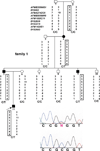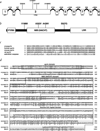Mutation of a new gene encoding a putative pyrin-like protein causes familial cold autoinflammatory syndrome and Muckle-Wells syndrome
- PMID: 11687797
- PMCID: PMC4322000
- DOI: 10.1038/ng756
Mutation of a new gene encoding a putative pyrin-like protein causes familial cold autoinflammatory syndrome and Muckle-Wells syndrome
Abstract
Familial cold autoinflammatory syndrome (FCAS, MIM 120100), commonly known as familial cold urticaria (FCU), is an autosomal-dominant systemic inflammatory disease characterized by intermittent episodes of rash, arthralgia, fever and conjunctivitis after generalized exposure to cold. FCAS was previously mapped to a 10-cM region on chromosome 1q44 (refs. 5,6). Muckle-Wells syndrome (MWS; MIM 191900), which also maps to chromosome 1q44, is an autosomal-dominant periodic fever syndrome with a similar phenotype except that symptoms are not precipitated by cold exposure and that sensorineural hearing loss is frequently also present. To identify the genes for FCAS and MWS, we screened exons in the 1q44 region for mutations by direct sequencing of genomic DNA from affected individuals and controls. This resulted in the identification of four distinct mutations in a gene that segregated with the disorder in three families with FCAS and one family with MWS. This gene, called CIAS1, is expressed in peripheral blood leukocytes and encodes a protein with a pyrin domain, a nucleotide-binding site (NBS, NACHT subfamily) domain and a leucine-rich repeat (LRR) motif region, suggesting a role in the regulation of inflammation and apoptosis.
Figures




Comment in
-
A fever gene comes in from the cold.Nat Genet. 2001 Nov;29(3):241-2. doi: 10.1038/ng1101-241. Nat Genet. 2001. PMID: 11687785 No abstract available.
References
-
- Kile RL, Rusk HA. A case of cold urticaria with an unusual family history. JAMA. 1940;114:1067–1068.
-
- Tindall JP, Beeker SK, Rosse WF. Familial cold urticaria. A generalized reaction involving leukocytosis. Arch. Intern. Med. 1969;124:129–134. - PubMed
-
- Zip CM, et al. Familial cold urticaria. Clin. Exp. Dermatol. 1993;18:338–341. - PubMed
-
- Ormerod AD, Smart L, Reid TM, Milford-Ward A. Familial cold urticaria. Investigation of a family and response to stanozolol. Arch. Dermatol. 1993;129:343–346. - PubMed
Publication types
MeSH terms
Substances
Associated data
- Actions
- Actions
- Actions
- Actions
- Actions
- Actions
- Actions
- Actions
- Actions
- Actions
- Actions
- Actions
- Actions
- Actions
Grants and funding
LinkOut - more resources
Full Text Sources
Other Literature Sources
Medical
Molecular Biology Databases
Research Materials
Miscellaneous

